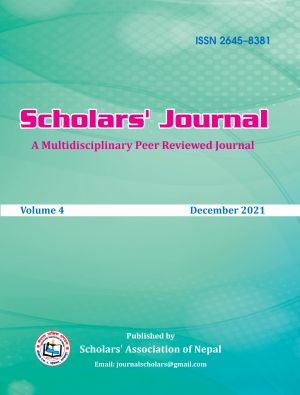नेपालमा एकीकृत पाठ्यक्रमबारे विज्ञहरूको अवधारणा {Concept of Experts on Integrated Curriculum in Nepal}
DOI:
https://doi.org/10.3126/scholars.v4i1.42642Keywords:
शैक्षिक उपलब्धि, Interdisciplinary, multidisciplinary, linguistic skills, teaching-learning, educational achievement, अन्तरविषयात्मक, बहुविषयात्मक, भाषिक सिप, शिक्षण सिकाइAbstract
धेरै विषयवस्तुलाई एकीकरण गरी अध्ययन अध्यापन गर्ने सिकाइलाई एकीकृत सिकाइ भनिन्छ । पाठ्यक्रम एकीकरणभनेको मानवीय जीवनमा आवश्यक पर्ने ज्ञानका कुराहरूलाई पाठ्यवस्तुको रूपमा विद्यार्थीका लागि बनाइने वा निर्माण गरिने प्रक्रिया हो । एकीकृत पाठ्यक्रम नेपालको सन्दर्भमा नयाँ आयाम हो । कक्षा एकमा २०७६ सालमा १०३ विद्यालयमा परीक्षण गरी २०७७ सालमा लागु गरियो भने कक्षा दुई र तीनमा २०७७ सालमा परीक्षण गरी २०७८ सालबाट लागु भएको छ । प्रस्तुत अध्ययन नेपालमा एकीकृत पाठ्यक्रमको अवधारणा भन्ने शीर्षकमा रहेको छ । यो लेख एकीकृत पाठ्यक्रमको ढाँचा तथा सिद्धान्त पहिचान गर्ने उद्देश्यमा आधारित छ । व्याख्यानात्मक अनुसन्धान विधि अन्तर्गत गुणात्मकढाँचा अवलम्बन गरिएको छ । यस अध्ययनमा तथ्याङ्क सङ्कलनका लागि असंरचित प्रश्न निर्माण गरी अन्तर्वार्ता लिएर गरिएको छ । यस अध्ययनमा असंरचित प्रश्नबाट प्राप्त तथ्याङ्कको विश्लेषण थिम निर्माण गरेर व्याख्या तथा वर्णनात्मक विधिबाट गरिएको छ । अध्ययनको प्राथमिक स्रोतका रूपमा विज्ञहरूको बुझाइलाई लिइएको छ । यस अध्ययनमा एकीकृत पाठ्यक्रमको परिचय, एकीकृत पाठ्यक्रमको निर्माण, एकीकृत पाठ्यक्रमको ढाँचा र सिद्धान्त, भाषिक उपलब्धि,विषय क्षेत्र जस्ता विविध पक्षहरूमा विज्ञहरूको अनुभव प्रस्तुत गरिएको छ । नेपालमा निर्माण गरिएको एकीकृत पाठ्यक्रमको ढाँचा सामाजिक अध्ययन, विज्ञान तथा वातावरण, स्वास्थ्य तथा शारीरिक शिक्षा र सिर्जनात्मक कला विषयलाई अन्तरविषयक (Interdisciplinary) ढाँचाको पाठ्यक्रमका रूपमा हाम्रो सेरोफेरो विषयक्षेत्रमा समावेश गरिएको छ भने पाठ्यक्रमको समग्र संरचनामा हाम्रो सेरोफेरो, गणित, नेपाली भाषा, अङ्ग्रेजी भाषा विषयक्षेत्रलाई समावेश गरी बहुविषयक(Multidisciplinary) ढाँचाको एकीकृत पाठ्यक्रम तयार गरिएको छ । यस अध्ययनबाट बालबालिकाले सिकाइलाईजीवनसँग जोड्न र सिकेको कुरालाई व्यवहारमा प्रयोग गर्न सक्ने बनाउन एकीकृत पाठ्यक्रमको आवश्यकता रहने जस्तामुख्य निष्कर्ष रहेका छन् । {Learning to teach by integrating multiple subjects is called integrated learning. Curriculum integration is the process of creating or constructing for students the lessons of knowledge needed in human life. The integrated curriculum is a new dimension in the context of Nepal. In class one, it was tested in 106 schools in 2076 BS and implemented in 2077 BS, while in class two and three it was tested in 2077 BS and implemented from 2078 BS. The present study is entitled Concept of Integrated Curriculum in Nepal. This article is based on the objective of identifying the structure and principles of integrated curriculum. Qualitative framework has been adopted under the explanatory research method. In this study, unstructured questions have been formulated and interviewed for data collection. In this study, the data obtained from the unstructured questions have been analyzed by formulating a thematic and descriptive method. Expert understanding is taken as the primary source of study. This study presents the experience of experts in various aspects such as introduction of integrated curriculum, development of integrated curriculum, structure and principles of integrated curriculum, linguistic achievement, subject area. Integrated curriculum developed in Nepal for interdisciplinary study of social studies, science and environment, health and physical education and creative arts. Our serofero subject area has been included as a framework curriculum while our serofero, mathematics, Nepali language, English language subject area has been included in the overall structure of the curriculum. The key findings from this study are the need for an integrated curriculum to connect children's learning with life and enable them to apply what they have learned in practice.}
Downloads
Downloads
Published
How to Cite
Issue
Section
License

This work is licensed under a Creative Commons Attribution-NonCommercial 4.0 International License.
Copyright © The Authors

